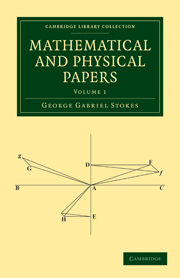Book contents
- Frontmatter
- PREFACE
- Contents
- On the Steady Motion of Incompressible Fluids
- On some cases of Fluid Motion
- On the Motion of a Piston and of the Air in a Cylinder
- On the Theories of the Internal Friction of Fluids in Motion, and of the Equilibrium and Motion of Elastic Solids
- On the Proof of the Proposition that (Mx + Ny)-1 is an Integrating Factor of the Homogeneous Differential Equation M+N dy/dx = 0
- On the Aberration of Light
- On Fresnel's Theory of the Aberration of Light
- On a Formula for determining the Optical Constants of Doubly Refracting Crystals
- On the Constitution of the Luminiferous Ether, viewed with reference to the Aberration of Light
- Report on Recent Researches on Hydrodynamics
- Supplement to a Memoir on some cases of Fluid Motion
- On the Theory of Oscillatory Waves
- On the Resistance of a Fluid to two Oscillating Spheres
- On the Critical Values of the Sums of Periodic Series
- Supplement to a paper on the Theory of Oscillatory Waves
- Index
On the Theories of the Internal Friction of Fluids in Motion, and of the Equilibrium and Motion of Elastic Solids
Published online by Cambridge University Press: 07 September 2010
- Frontmatter
- PREFACE
- Contents
- On the Steady Motion of Incompressible Fluids
- On some cases of Fluid Motion
- On the Motion of a Piston and of the Air in a Cylinder
- On the Theories of the Internal Friction of Fluids in Motion, and of the Equilibrium and Motion of Elastic Solids
- On the Proof of the Proposition that (Mx + Ny)-1 is an Integrating Factor of the Homogeneous Differential Equation M+N dy/dx = 0
- On the Aberration of Light
- On Fresnel's Theory of the Aberration of Light
- On a Formula for determining the Optical Constants of Doubly Refracting Crystals
- On the Constitution of the Luminiferous Ether, viewed with reference to the Aberration of Light
- Report on Recent Researches on Hydrodynamics
- Supplement to a Memoir on some cases of Fluid Motion
- On the Theory of Oscillatory Waves
- On the Resistance of a Fluid to two Oscillating Spheres
- On the Critical Values of the Sums of Periodic Series
- Supplement to a paper on the Theory of Oscillatory Waves
- Index
Summary
The equations of Fluid Motion commonly employed depend upon the fundamental hypothesis that the mutual action of two adjacent elements of the fluid is normal to the surface which separates them. From this assumption the equality of pressure in all directions is easily deduced, and then the equations of motion are formed according to D'Alembert's principle. This appears to me the most natural light in which to view the subject; for the two principles of the absence of tangential action, and of the equality of pressure in all directions ought not to be assumed as independent hypotheses, as is sometimes done, inasmuch as the latter is a necessary consequence of the former The equations of motion so formed are very complicated, but yet they admit of solution in some instances, especially in the case of small oscillations. The results of the theory agree on the whole with observation, so far as the time of oscillation is concerned. But there is a whole class of motions of which the common theory takes no cognizance whatever, namely, those which depend on the tangential action called into play by the sliding of one portion of a fluid along another, or of a fluid along the surface of a solid, or of a different fluid, that action in fact which performs the same part with fluids that friction does with solids.
Thus, when a ball pendulum oscillates in an indefinitely extended fluid, the common theory gives the arc of oscillation constant.
- Type
- Chapter
- Information
- Mathematical and Physical Papers , pp. 75 - 129Publisher: Cambridge University PressPrint publication year: 2009First published in: 1880
- 41
- Cited by

